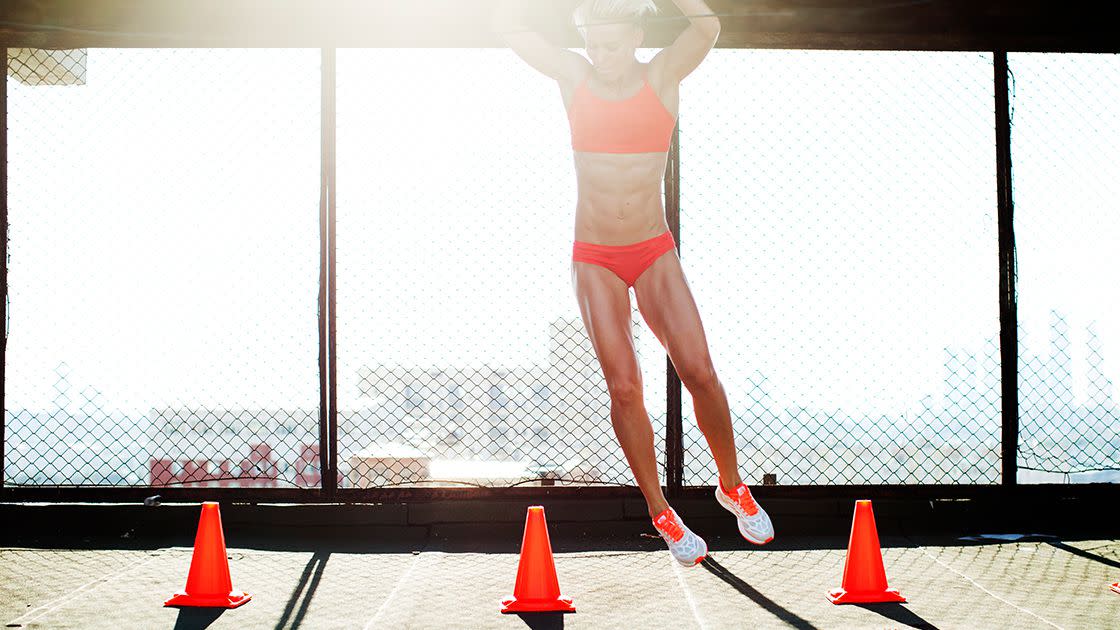Why You Should Add Lateral Exercises to Your Workouts

Photo: yulkapopkova / Getty Images
If you're a runner or cyclist, you mostly move your body forward when you exercise. If you're a weightlifter or swimmer, you might occasionally move your body backward by doing reverse lunges or backstroke. But the reality is, the most popular activities people choose for getting fit don't generally require moving to the side. (That's part of why cross-training workouts are essential for runners.)
That doesn't make them less valuable, but it does mean you may want to put a little extra effort into moving your body in other directions. Ahead, fitness experts explain why, plus how to incorporate lateral exercises into your routine.
Why Lateral Movement Matters
So why are we making such a big deal about moving side-to-side? "It's typically not asked of us often," says Joe Holder, trainer and member of The Vitamin Shoppe Wellness Council. "We move front to back and rarely side to side because we like to lead with our eyes first." Plus, our environments are much more controlled (think sitting in front of a computer, sitting in a car, walking down the street) than they were in the past, when multi-plane motion was much more necessary, he says.
Okay, so maybe our ancestors were moving around in different directions more than we do, but is that really such a big deal? Well, kind of. Here's what lateral movement does for our bodies:
It can help prevent injury and may help even out imbalances. "Forward movements like running and biking use the same dominant muscles, stressing your hamstrings, calves, and quads," explains Tara Laferrara, a certified personal trainer, yoga teacher, founder of the TL Method, and co-owner of Compass Fitness. "You stress the dominant muscle groups, causing them to become increasingly stronger as your smaller muscles stay the same." This can cause an imbalance, which can lead to injury. "Working the muscles on the inside and outside of your legs, for example, helps stabilize your hips and pelvis, keeping you injury-free," she adds. (See: How to Diagnose and Fix Some of Your Body Imbalances)
It can make you stronger. "Working smaller stabilizer muscles is just as important as working larger dominant muscles because it gets them ready for high performance," says Laferrara. "Firing up your inner thighs and glutes gets your hamstrings ready to deadlift 200 pounds." Talk about #goals.
Variety is a good thing. "It's fun to change things up from time to time," points out Joe Cannon, C.S.C.S., a personal trainer. "Doing different activities-like moving in different planes of motion-can reduce boredom and increase exercise adherence (which is a fancy way to say you're more likely to work out)."
How to Incorporate Lateral Exercises Into Your Routine
So lateral exercises are important. But how do you actually do them? "There are two ways to perform a lateral movement: abduction (moving a limb away from your body) and adduction (bringing that limb back in)," notes Laferrara. "These movements stabilize your joints and dominant muscles."
Laferrara says she includes lateral exercises in all parts of a workout (warm-up, workout, and cooldown) but she finds them especially important in the warm-up. "You are preparing your body for any movement that will occur in the workout," she points out. Even as a trail runner-which is primarily a forward movement-at one point you will have to jump to the side to avoid tripping over a rock or other obstacle. You HAVE to get your body ready for that."
Not sure where to start? Here are some ideas, courtesy of Holder. He recommends adding them into your regular workouts one to two times per week.
Side lunges: 3 sets of 12 reps per leg (BTW, here's why the side lunge is an essential part of every leg workout.)
Side shuffles: 3 sets of 20 yards per leg
Lateral bear crawls: 3 sets of 20 yards each way
Jumping jacks or star jumps: 3 sets of 30 seconds
Speed skaters: 3 sets of 10 reps per leg

